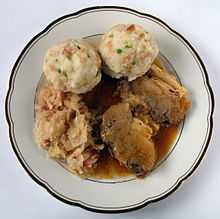Entrée
| Part of a series on |
| Meals |
|---|
 |
| Common meals |
| Components and courses |
| Related concepts |
In French cuisine, an entrée (/ˈɑːntreɪ/ /ˈɒntreɪ/ AHN-tray; French "entrance") is a dish served before the main course, or between two principal courses of a meal.[1][2][3]
In North American English, the term is instead used to describe the main course, due to the disappearance in the early 20th century of a large communal main course such as a roast as a standard part of the meal in the English-speaking world. This use of the term is unusual (but not unheard of) outside North America, as most other English speakers follow the original French usage, generally considering the word "entrée" to mean a first course.[1][4][5][6]
In 1970, Richard Olney, an American living in Paris, gave the place of the entrée in a French full menu: "A dinner that begins with a soup and runs through a fish course, an entrée, a sorbet, a roast, salad, cheese and dessert, and that may be accompanied by from three to six wines, presents a special problem of orchestration".[7] In 1967 Julia Child and her co-authors[8] outlined the character of such entrées, which – when they did not precede a roast – might serve as the main course of a luncheon, in a chapter of "Entrées and Luncheon Dishes" that included quiches, tarts and gratins, soufflés and timbales, gnocchi, quenelles and crêpes.
Use


Marie-Antoine Carême explained for a French readership the order of courses in the state dinner à la russe served for Tsar Alexander I's review of his troops in 1815, at an isolated location far from Paris, under trying circumstances:
Russian service is carried out rapidly and warmly; first, oysters are served; after the soup, hors d'oeuvres; then the large joint of meat; then the entrées of fish, fowl, game, meat, and the entremets of vegetables; then the roast meat with salad. The service ends with the desserts: jellies, creams and soufflés.[9]
In Mrs Beeton's Book of Household Management, chapter 40, bills of fare for a grand dinner for eighteen, January 1887,[10] follow two kinds of fish and two kinds of soup with four entrées: Ris de Veau, Poulet à la Marengo, Côtelettes de Porc and a Ragoût of Lobster. Guests were not expected to eat of each dish, of course, for the entrées were followed by a Second Course and a Third Course, of game and fruit.
An entrée is more substantial than hors d'œuvres and better thought of as a half-sized version of a main course, and restaurant menus will sometimes offer the same dish in different-sized servings as both entrée and main course.
Entrée (or entree) is often used in the United States and certain parts of Canada (except Quebec) as the name of the main course.[11] English-speaking Québécois follow the French use of the term.
Origins

_Course.jpg)
The word entrée in French originally denoted the "entry" of the dishes from the kitchens into the dining hall. In the illustration from a French fifteenth-century illuminated manuscript of the Histoire d'Olivier de Castille et d'Artus d'Algarbe, a fanfare from trumpeters in the musicians' gallery announces the processional entrée of a series of dishes preceded by a covered cup that is the ancestor of the tureen, carried by the maître d'hôtel. The entrée will be shown round the hall but served only to the high table (though it does not stand on a dais in this hall), where the guests are set apart by a gold-and-crimson damask canopy of estate.
In traditional French haute cuisine, the entrée preceded a larger dish known as the relevé, which "replaces" or "relieves" it, an obsolete term in modern cooking, but still used as late as 1921 in Escoffier's Le Guide Culinaire.
In France, the modern restaurant menu meaning of "entrée" is the course that precedes the main course in a three-course meal,[12] i.e. the course which in British usage is often called the "starter" and in American usage the "appetizer". Thus a typical modern French three-course meal in a restaurant consists of "entrée" (first course, starter (UK), appetizer (U.S.)) followed by the "plat" or "plat principal" (the main course) and then dessert or cheese. This procession is commonly found in prix fixe menus.
See also
References
- ↑ 1.0 1.1 Oxford Dictionaries
- ↑ American Heritage Dictionary
- ↑ According to Alexandre Dumas' Grand dictionnaire de cuisine (1871), an entrée is a "Préparation chaude qui accompagne ou suit le potage," a "hot preparation that accompanies or follows the soup".
- ↑ Macmillan
- ↑ Longman
- ↑ cf. Cambridge
- ↑ Olney, The French Menu Cookbook 1970:22.
- ↑ Julia Child, Louisette Bertholle, Simon Beck, Mastering the Art of French Cooking, 1967.
- ↑ Carême, Le Maître d'hôtel français, quoted in Goldstein, Darra (1995). "Russia, Carême, and the Culinary Arts". The Slavonic and East European Review 73 (4): 691–715 [p. 695]. JSTOR 4211935.
- ↑ On-line text.
- ↑ Stewart, Marjabelle Young and Elizabeth Lawrence (1999). Commonsense Etiquette: A Guide to Gracious, Simple Manners for the Twenty-First Century. St. Martin's Press. p. 99.
- ↑ Source for the meaning of entrée: universal usage on menus in France and Larousse Dictionnaire Français-Anglais / Anglais-Français, s.v. "Entrée (7)".
External links
| Look up entrée in Wiktionary, the free dictionary. |
| Wikimedia Commons has media related to Entrée. |
- Why Americans say Entrée when everyone else says Main
- The Straight Dope on the meaning of entrée
- Wikibooks Cookbook